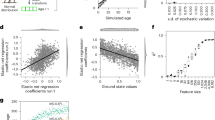Abstract
Studies of the nematode worm Caenorhabditis elegans have led to the widely held belief that individuals of a given nematode species are characterized by a property known as eutely, in which all individuals have the same total number of cells1. This property, which is peculiar to nematodes and a few other phyla, has raised the question of whether the developmental mechanisms of nematodes differ from those of larger metazoans. Here we show that many, perhaps most, nematode species are not eutelic in at least one organ, the epidermis, and that in this respect they resemble other model organisms such as fruitflies and mice.
This is a preview of subscription content, access via your institution
Access options
Subscribe to this journal
Receive 51 print issues and online access
$199.00 per year
only $3.90 per issue
Buy this article
- Purchase on Springer Link
- Instant access to full article PDF
Prices may be subject to local taxes which are calculated during checkout

Similar content being viewed by others
References
Van Cleave, H. J. Q. Rev. Biol. 7, 59–67 (1932).
Sulston, J. E. & Horvitz, H. R. Dev. Biol. 56, 110–156 (1977).
Sulston, J. E. et al. Dev. Biol. 100, 64–119 (1983).
Kimble, J. & Hirsh, D. Dev. Biol. 70, 396–417 (1979).
Sternberg, P. W. & Horvitz, H. R. Dev. Biol. 93, 181–205 (1982).
Ambros, V. & Fixsen, W. in Development as an Evolutionary Process (eds Raff, R. A. & Raff, E. C.) 139–159 (Liss, New York, 1987).
Sommer, R. J., Carta, L. K. & Sternberg, P. W. Development 120, 85–95 (1994).
Voronov, D. A. & Panchin, Y. V. Development 125, 143–150 (1998).
Purvis, A. & Rambaut, A. Comput. Appl. Biosci. 11, 247–251 (1995).
Azevedo, R. B. R. et al. Nematology (in the press).
Rusin, L. U. R. & Malakov, V. V. Doklady Biol. Sci. 361, 331–333 (1998).
Fitch, D. H., Bugaj-Gaweda, B. & Emmons, S. W. Mol. Biol. Evol. 12, 346–358 (1995).
Blaxter, M. L. et al. Nature 392, 71–75 (1998).
Author information
Authors and Affiliations
Corresponding author
Rights and permissions
About this article
Cite this article
Cunha, A., Azevedo, R., Emmons, S. et al. Variable cell number in nematodes. Nature 402, 253 (1999). https://doi.org/10.1038/46211
Issue Date:
DOI: https://doi.org/10.1038/46211
This article is cited by
-
Variable ITS-copy number at different developmental stages of Meloidogyne hapla and M. chitwoodi
European Journal of Plant Pathology (2019)
-
Development of qPCR assays for quantitative detection of Heterodera avenae and H. latipons
European Journal of Plant Pathology (2015)
-
Quantitative detection of the root-lesion nematode, Pratylenchus penetrans, using qPCR
European Journal of Plant Pathology (2013)
-
Greater coverage of the phylum Nematoda in SSU rDNA studies
Biology and Fertility of Soils (2011)
Comments
By submitting a comment you agree to abide by our Terms and Community Guidelines. If you find something abusive or that does not comply with our terms or guidelines please flag it as inappropriate.



